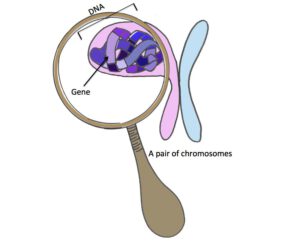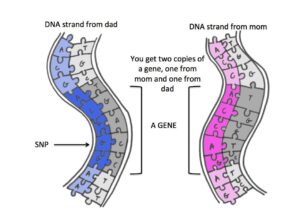I’m sorry to burst your bubble, but you don’t have a gene for being tall, or a gene for caffeine addiction or a gene for intelligence. No one does.
In an effort to simplify the science, the media sometimes talks about genetics and the influence of genes in these terms.
But there is not a “breast cancer gene,” or a “warrior gene.”
It’s much more complicated than that. With a few exceptions, everyone has the same genes. But within these genes, there are slight variations – different genotypes – and it’s those small variations that makes us all unique.
So when a customer asks:
“Do I have this gene?”
Technically speaking, the answer is always:
“Yes.”
The thing is, that’s not really what they are asking. They want to know if they have the genotypes that influence a certain trait. To understand what I mean by genotype, it helps to review a little biology.
Think of your DNA as one long string. A very, very long string that’s crammed into every cell in your body. This string is broken into many segments with each segment serving a different purpose. These segments of DNA are called genes.
Genes provide instructions for your body to produce different proteins. Proteins influence nearly every function of your body. Some proteins effect visible traits like the color of your eyes. Others prompt biological functions from the ability to lift your arm to intricate cell processes.
With only a few exceptions, everyone has the same genes, so it’s not the presence or absence of a gene that is variable.* It’s what is within those genes that is different. Each gene contains many positions, and each position is associated with a single genotype. It is the genotypes on a particular gene that make all the difference.
Let’s break this down a bit more.
Your DNA is made up of nucleotide bases – adenine, cytosine, guanine, and thymine. Your A’s, C’s, G’s and T’s, if you will. You can think of these bases like puzzle pieces. They bind with one another to form your DNA. Your DNA is organized into twenty-three pairs of chromosomes. These bases together make up your genotype at that position. A genotype is written using the two letters of the two nucleotide bases at a particular position, such as AA or CT.
There are several ways scientists refer to particular points in your DNA.
At 23andMe, we perform genotyping by analyzing single nucleotide polymorphisms (SNPs). It is a location on your DNA where the genotype can vary among people. This means that your genotype at that position may differ from other individuals.
Different genotypes at a particular SNP can indicate something about your physical characteristics, or potential genetic health risk. Genotyping services base interpretations on your genotype for a particular SNP or SNPs, not the presence or absence of a gene.
For example, the type of earwax you have is dependent on a single SNP located on the ABCC11. If your genotype at this SNP is TT, then you have dry earwax. If you have any other genotype at this SNP, then you have wet earwax.
And that’s it! So the next time you wonder if you have a particular gene, you’ll know it’s a bit more complicated than that. It’s all about those base pairs.
___
*There are some conditions caused by gene deletions. 23andMe is not well-suited to detect such genetic changes.
**The exception to this are the sex chromosomes.

